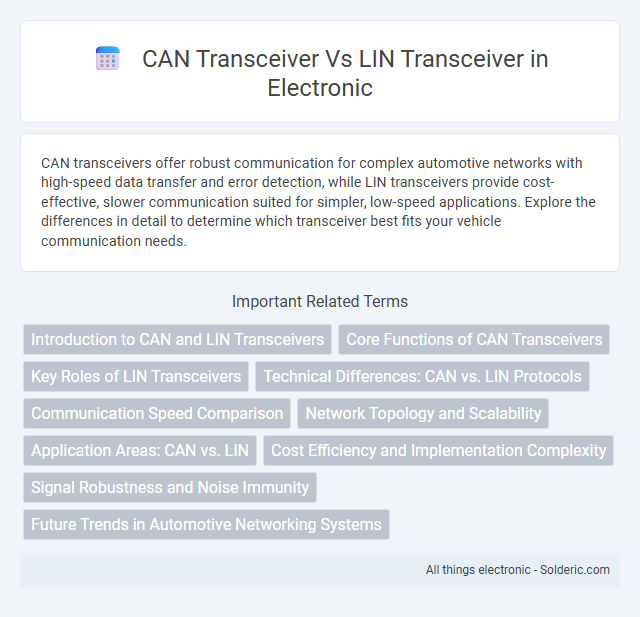CAN transceivers offer robust communication for complex automotive networks with high-speed data transfer and error detection, while LIN transceivers provide cost-effective, slower communication suited for simpler, low-speed applications. Explore the differences in detail to determine which transceiver best fits your vehicle communication needs.
Comparison Table
| Feature | CAN Transceiver | LIN Transceiver |
|---|---|---|
| Protocol | Controller Area Network (CAN) | Local Interconnect Network (LIN) |
| Data Rate | Up to 1 Mbps (High-speed CAN) | Up to 20 Kbps |
| Topology | Multi-master, bus topology | Single-master, single-wire bus |
| Wiring | Two-wire differential signaling | Single-wire |
| Error Detection | Advanced error detection with CRC, ACK, bit monitoring | Basic checksum error detection |
| Use Case | Real-time control in automotive, industrial automation | Low-cost sensor communication in automotive systems |
| Complexity & Cost | Higher complexity and cost | Lower complexity and cost |
| Power Consumption | Moderate to high | Low |
Introduction to CAN and LIN Transceivers
CAN transceivers enable robust communication in automotive and industrial networks by supporting Controller Area Network protocols with high-speed data transfer and error detection. LIN transceivers cater to low-cost, low-speed communication in vehicle sub-systems, offering simplicity and reduced wiring complexity for sensor and actuator networks. Your choice between CAN and LIN transceivers depends on the required network performance, complexity, and cost constraints.
Core Functions of CAN Transceivers
CAN transceivers primarily facilitate robust communication between microcontrollers and the CAN bus by converting digital signals into differential signals for high noise immunity and error detection. They support features such as fault confinement, bit timing, and arbitration to ensure reliable data exchange in automotive and industrial networks. CAN transceivers manage dominant and recessive states on the bus, enabling synchronized data transmission and reception across multiple nodes.
Key Roles of LIN Transceivers
LIN transceivers enable reliable communication in low-cost automotive networks by converting digital signals between the Local Interconnect Network (LIN) protocol and the physical bus. They play a critical role in synchronizing data transmission, managing wake-up signals, and ensuring error detection within the LIN bus system. Unlike CAN transceivers designed for high-speed, complex networks, LIN transceivers focus on cost-efficient, low-speed communication for body electronics and simple sensor modules.
Technical Differences: CAN vs. LIN Protocols
CAN transceivers support the Controller Area Network protocol, enabling high-speed, multi-master communication with error detection and fault confinement features, ideal for complex automotive networks. LIN transceivers operate on the Local Interconnect Network protocol, designed for low-speed, single-master, multi-slave communication with simpler schema and lower cost. CAN offers higher data rates up to 1 Mbps and robust error handling compared to LIN's maximum 20 Kbps and basic error detection suitable for less critical body control applications.
Communication Speed Comparison
CAN transceivers support communication speeds up to 1 Mbps, making them ideal for applications requiring fast and reliable data transfer. LIN transceivers, on the other hand, typically operate at speeds up to 20 Kbps, suited for slower, less complex networking tasks. Your choice between CAN and LIN transceivers should consider the required communication speed for efficient system performance.
Network Topology and Scalability
CAN transceivers support a multi-master bus topology, allowing multiple nodes to communicate efficiently over a single twisted-pair cable, which enhances scalability in complex automotive networks. LIN transceivers utilize a master-slave single-wire network topology, limiting scalability due to the sequential communication and fewer connected nodes. The flexibility of CAN networks facilitates integration of numerous control units, whereas LIN networks are best suited for lower-speed, simpler applications with fewer devices.
Application Areas: CAN vs. LIN
CAN transceivers are widely used in automotive systems requiring high-speed, robust communication, such as engine management, antilock braking systems, and advanced driver-assistance systems (ADAS). LIN transceivers are ideal for lower-speed, cost-sensitive applications like interior lighting, seat positioning, and climate control, where simple, efficient communication suffices. Your choice between CAN and LIN transceivers depends on the complexity and criticality of the application environment.
Cost Efficiency and Implementation Complexity
CAN transceivers typically offer higher cost efficiency for complex automotive networks due to their robustness and widespread industry adoption, enabling lower per-unit costs in large volumes. LIN transceivers are usually simpler and cheaper for low-speed, single-wire communication, making them ideal for cost-sensitive applications with minimal wiring requirements. Your choice depends on balancing implementation complexity against network demands, where LIN suits simple control nodes and CAN handles intricate data exchange efficiently.
Signal Robustness and Noise Immunity
CAN transceivers offer superior signal robustness and noise immunity compared to LIN transceivers, enabling reliable communication in high-interference automotive environments. The differential signaling technique used by CAN transceivers effectively reduces electromagnetic interference and ensures accurate data transmission over longer distances. In contrast, LIN transceivers utilize single-wire communication, which is more susceptible to noise and voltage fluctuations, limiting their robustness in electrically noisy conditions.
Future Trends in Automotive Networking Systems
CAN transceivers continue evolving with higher data rates and enhanced fault tolerance, supporting increasingly complex automotive networks for autonomous driving and advanced driver-assistance systems (ADAS). LIN transceivers maintain relevance in cost-sensitive applications with improved low-power designs and integration suited for body electronics and sensor communication. The convergence of CAN and LIN in hybrid networks aims to optimize bandwidth, reliability, and scalability for future electric and connected vehicles.
CAN transceiver vs LIN transceiver Infographic

 solderic.com
solderic.com